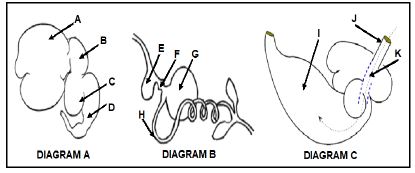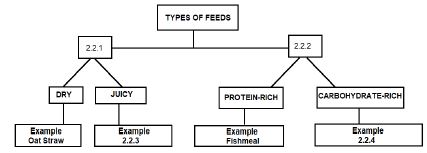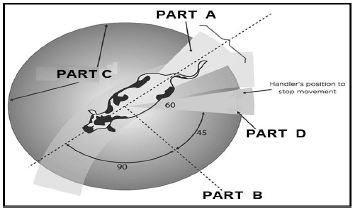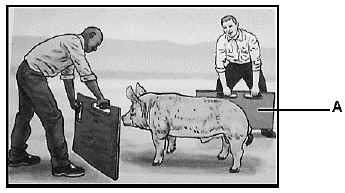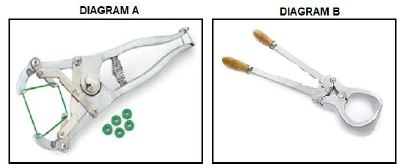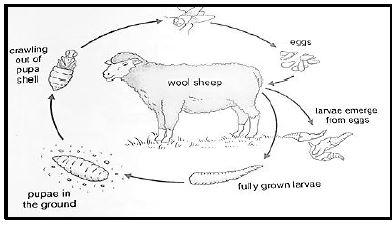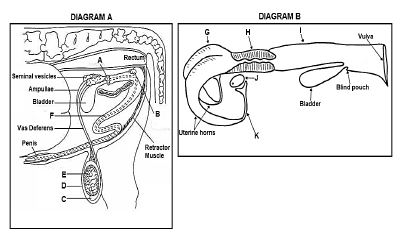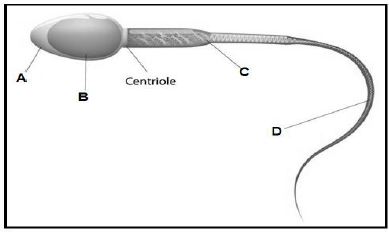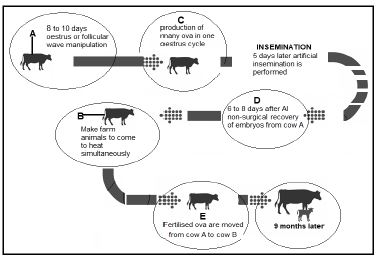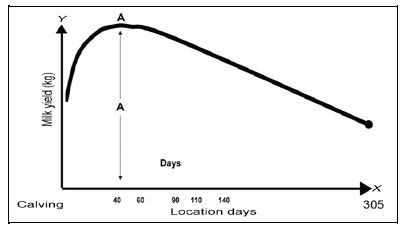AGRICULTURAL SCIENCES GRADE 12 QUESTIONS - NSC PAST PAPERS AND MEMOS JUNE 2022
Share via Whatsapp Join our WhatsApp Group Join our Telegram GroupINSTRUCTIONS AND INFORMATION
- This question paper consists of TWO sections, namely SECTION A and SECTION B.
- Answer ALL the questions in the ANSWER BOOK.
- Start EACH question on a NEW page.
- Number the answers correctly according to the numbering system used in this question paper.
- You may use a non-programmable calculator.
- Show ALL calculations, including units and formulae, where applicable.
- Write neatly and legibly.
SECTION A
QUESTION 1
1.1 Various options are provided as possible answers to the following questions. Choose the answer and write only the letter (A to D) next to the question numbers (1.1.1 to 1.1.10) in the ANSWER BOOK, for example, 1.1.11 D .
1.1.1 A thick greyish acidic liquid produced in the stomach from churning the bolus and gastric juices.
- Bile
- Succus entericus
- Chyme
- Cud
1.1.2 … is an indication of the protein content of a feed.
- Digestibility
- Nutritive ratio
- Energy value
- Biological value
1.1.3 The fundamental processes in the digestive system from mouth to anus, occurs in the following sequence:
- Ingestion, absorption, assimilation, digestion and egestion
- Egestion, digestion, absorption, assimilation and ingestion
- Egestion, assimilation, digestion, absorption and ingestion
- Ingestion, digestion, absorption, assimilation and egestion
1.14 The requirements below are correct with regard to normal functioning of rumen microbes:
- Aerobic conditions
- pH of 5,5 to 6,5
- Presence of volatile fatty acids for growth
- A temperature of 38 °C to 42 °C
Choose the correct combination below:- (i), (ii) and (iv)
- (ii), (iii) and (iv)
- (i), (ii) and (iii)
- (i), (iii) and (iv)
1.1.5 ONE of the following is NOT a factor to increase production in extensive farming:
- Nutrition
- Environment
- General behaviour
- Reproduction
1.1.6 The equipment below is used by livestock farmers for …
- dipping.
- vaccination.
- injection.
- dosing.
1.1.7 During extremely hot days, ruminant animals will …
- eat less and drink more water.
- eat more and drink less water.
- eat less and drink less water.
- eat more and drink more water.
1.1.8 The following applies to the battery-cage system:
- Chickens are kept in cages to restrict their movement
- Chickens have no direct contact with their faeces
- Reduced risks and there is less expenditure on vaccines
- Group of birds are allowed to roam around freely during the day
Choose the correct combination below:- (i), (ii) and (iv)
- (i), (ii) and (iii)
- (ii), (iii) and (iv)
- (i), (iii) and (iv)
1.1.9 One of the following is an example of a primary female reproductive organ:
- Ovaries
- Uterus
- Testis
- Vagina
1.1.10 The layer of the blastocyst responsible for the nutrition of the embryo is the …
- embryoblast.
- mesoderm.
- ectoderm.
- trophoblast. (10 x 2)
(20)
1.2 Indicate whether each of the following statements in COLUMN B applies to A ONLY, B ONLY, BOTH A AND B or NONE of the items in COLUMN A. Write A only, B only, both A and B or None next to the question number (1.2.1 to 1.2.5) in the ANSWER BOOK, for example 1.2.6 B only.
Example:
| COLUMN A | COLUMN B | ||
| 1.2.6 | A: | Fungal disease | An example is coccidiosis |
| B: | Bacterial disease | ||
Answer: 1.2.6 None
| COLUMN A | COLUMN B | ||
| 1.2.1 | A: | Passive absorption | Movement of molecules against concentration gradient |
| B: | Active absorption | ||
| 1.2.2 | A: | Abomasum | Digestive enzymes hydrolyse protein to form amino acids |
| B: | Duodenum | ||
| 1.2.3 | A: | Intravenously | Injecting animals between layers of the skin |
| B: | Subcutaneously | ||
| 1.2.4 | A: | Urea poisoning | Excessive salivation by the farm animal |
| B: | Plant poisoning | ||
| 1.2.5 | A: | Nuclear transfer | Expensive and requires a specific set of skills |
| B: | Embryo transfer | ||
(5 x 2) (10)
1.3 Give ONE term/phrase for each of the following descriptions. Write only the term/phrase next to the question number (1.3.1 to 1.3.5) on the ANSWER BOOK.
1.3.1 Feed that is less bulky, more expensive dried with small volume per mass, easily digested and with a high nutritive value
1.3.2 A collective term referring to infectious diseases transmitted between humans and farm animals
1.3.3 Cell division that halves the number of chromosomes to form four haploid daughter cells genetically different from parents
1.3.4 The condition when the farm animal possesses both male and female reproductive organs
1.3.5 A condition in farm animals where the testes remain in the abdominal cavity and do not descend to the scrotum (5 x 2)
(10)
1.4 Change the UNDERLINED WORD(S) in each of the following statements to make them TRUE. Write only the answer next to the question numbers
(1.4.1 to 1.4.5) in the ANSWER BOOK.
1.4.1 A supplement programme is a strategic plan by livestock farmers to ensure that there is sufficient feed to meet the requirements of the herd throughout the year.
1.4.2 Pandemic is when a disease occurs in a population regularly within a particular region and can be predicted.
1.4.3 The head contains centrioles that assist the sperm cell to get through the egg cell’s protective coat for fertilisation to occur.
1.4.4 Gestation is difficult parturition when a female animal is unable to deliver the young one.
1.4.5 Sterility is the temporal inability of an animal to reproduce successfully. (5 x 1)
(5)
TOTAL SECTION A: 45
SECTION B
QUESTION 2: ANIMAL NUTRITION
Start this question on a NEW page.
2.1 The diagrams below represent the alimentary canal of farm animals.
2.1.1 Classify the farm animals with the alimentary canals represented by DIAGRAM A and DIAGRAM B above. (2)
2.1.2 Identify parts E and J from the diagrams above. (2)
2.1.3 Identify the alimentary canal of a young ruminant animal from those shown above. (1)
2.1.4 Justify your answer to QUESTION 2.1.3. (1)
2.1.5 Identify the letters (A–K) representing an organ where each of the following function occurs:
- Absorption of soluble end products of digestion into the bloodstream (1)
- Enzymatic digestion in DIAGRAM B (1)
- Microbial fermentation of ingested feed in DIAGRAM A (1)
2.2 Complete the schematic representation below by writing down the answers next to the question numbers 2.2.1 to 2.2.4. (4)
2.3 Name the disease/condition caused by deficiency of the following vitamin/mineral:
2.3.1 Iodine in calves (1)
2.3.2 Vitamin K in poultry (1)
2.3.3 Zinc (1)
2.4 The largest portion of a feed is used in the production of energy for the farm animal.
2.4.1 Indicate the units used to express energy in nutrition. (1)
2.4.2 Give TWO important uses of Net Energy. (2)
2.4.3 Name TWO purposes of calculating energy value of feed (2)
2.5 The feeds below are available for the farmer to formulate a ration for dairy cows in early lactation:
| FEED | DIGESTIBLE PROTEIN VALUE (%) | REQUIRED DIGESTIBLE PROTEIN VALUE (%) |
| Barley meal | 9 | 16 |
| Soya oilcake meal | 39 |
2.5.1 Calculate the ratio into which the two feeds above should be mixed for the dairy cows to get the required digestible protein. (4)
2.5.2 Calculate the percentage of soya oilcake meal in the mixture. Show ALL calculations. (3)
2.6 A cow ingested 15 kg of hay with a moisture content of 10%, and egested 3 kg of dry manure. Calculate the coefficient of digestibility of the hay. (5)
2.7 Indicate TWO importance of fodder flow planning. (2)
[35]
QUESTION 3: ANIMAL PRODUCTION, PROTECTION AND CONTROL
Start this question on a NEW page.
3.1 The table below represents two farmers (FARMER A and FARMER B) practising different production systems:
| FARMER A | FARMER B |
A beef farmer raising livestock in an area with:
| A dairy farmer with:
|
3.1.1 Identify from the table above the animal production system represented by FARMER A and FARMER B. (2)
3.1.2 Justify the answer to QUESTION 3.1.1 based on the information provided in the table. (2)
3.1.3 Differentiate between subsistence and commercial farming systems. (2)
3.2 Suggest THREE measures that a farmer should take to reduce heat stress in cattle under intensive production. (3)
3.3 Farm animals have their own space around them, how and when a handler steps into their space affects an animal’s movement.
Identify from the diagram below the part that represents each of the following:
3.3.1 Flight zone (1)
3.3.2 Blind spot (1)
3.3.3 Point of balance (1)
3.4 The picture below shows a pig moved with the aid of the handling equipment.
3.4.1 Identify the equipment labelled A in the picture above. (1)
3.4.2 Name THREE reasons for the handling of pigs by farmers. (3)
3.5 The diagrams below represent the management tools that are used on a farm.
3.5.1 Name the management practice that the tools in DIAGRAM A and DIAGRAM B are used for. (1)
3.5.2 Choose a tool between DIAGRAM A and DIAGRAM B which is most suitable for the following:
- Adult farm animals (1)
- Younger farm animals (1)
3.6 Answer the following questions based on the scenario below.
| A viral disease which spreads to sheep, cattle and goats by mosquitos and causes abortion and death of the farm animals. People can also get the disease if they handle blood, tissues or other body fluids of infected animals, but it does not spread from person to person. It is required by law that a farmer reports to authorities if they suspect they have been infected with this disease. |
3.6.1 Name the disease described in the scenario above. (1)
3.6.2 Identify the following from the scenario above:
- Vector (1)
- Pathogen (1)
3.6.3 Extract from the scenario above a sentence stating that the disease is a notifiable disease. (1)
3.6.4 Suggest TWO economic implications of animal diseases to the farmer. (2)
3.7 The schematic representation below shows the life cycle of a parasite.
3.7.1 Identify the parasite in the life cycle above. (1)
3.7.2 Indicate the most harmful stage in the life cycle of the parasite above. (1)
3.7.3 Identify the condition that cause wounds on the skin of wool sheep due to biting by the parasite mentioned in QUESTION 3.7.1. (1)
3.7.4 Give the term used for the removal of wool around the tail and rear leg areas. (1)
3.7.5 Suggest THREE non-chemical management practices used to control infestation by the parasite in QUESTION 3.7.1. (3)
3.8 Indicate whether each of the following roles in animal health are mainly performed by the farmer or the state.
- Import and export bans (1)
- Research (1)
- Sanitation (1)
[35]
QUESTION 4: ANIMAL REPRODUCTION
Start this question on a NEW page.
4.1 The diagrams below represent the reproductive systems of a cow and bull.
4.1.1 Identify the parts labelled F, G and K from DIAGRAM A and DIAGRAM B above. (3)
4.1.2 Match the functions listed below with a letter (A–K) from DIAGRAM A and DIAGRAM B above.
- Physical barrier to the uterus that secretes mucous plug during pregnancy (1)
- Serves as a site for fertilisation (1)
- Produce female gametes and hormones (1)
- Organ of copulation in cows (1)
- Stores spermatozoa until maturity (1)
- Secretes a milky, slightly alkaline mucus that gives semen its characteristic smell(1)
4.2 The picture below represents a male gamete.
Indicate the letter of a part that represents each of the following functions:
- Propelling the sperm cell forward (1)
- Production of energy (1)
- Centre of all activities of a cell (1)
4.3 The table below indicates the characteristics of the semen of different species.
| Species | Volume (mℓ) | Sperm concentration (x 109/mℓ) | % Motility | % Normal |
| Bull | 8,0 | 1,5 | 75 | 95 |
| Ram | 1,0 | 3,0 | 95 | 95 |
| Boar | 200 | 0,25 | 70 | 90 |
| Stallion | 80 | 0,15 | 80 | 90 |
4.3.1 Use the information from the table above to draw a combined bar graph showing the motility and normal percentages of different species. (6)
4.3.2 Identify the species with the highest concentration from the table above. (1)
4.4 The list below shows stages of mating.
4.4.1 Arrange the statements relating to stages of mating presented below in sequential order. Write down ONLY the letters (A–D).
- Gaining intromission into the vagina
- Bull jumps off the cow’s rump and move away
- Bull stands on its hind legs with chest rested on cow’s rump
- Ejaculation of semen into vagina (4)
4.4.2 Name the stage of mating not listed in QUESTION 4.4.1 above. (1)
4.4.3 Indicate the stage during oestrus cycle when a cow will allow the action at stage A (1)
4.4.4 State ONE sign of a cow during the stage mentioned in QUESTION 4.4.3. (1)
4.5 The illustration below represents a procedure used by farmers for animal reproduction.
4.5.1 Identify the animal reproduction procedure illustrated above. (1)
4.5.2 Name the farm animal A and farm animal B from the illustration above. (2)
4.5.3 Suggest the name of the processes indicated by C and D. (2)
4.6 The curve below shows the production on a dairy farm.
4.6.1 Name the curve represented by the illustration above. (1)
4.6.2 Suggest the name given to A on the graph. (1)
4.6.3 Name the hormone responsible for the following functions:
- Development of mammary glands and stimulation of milk production(1)
- Stimulates the release of milk during milking (1)
[35]
TOTAL SECTION B: 105
GRAND TOTAL: 150

